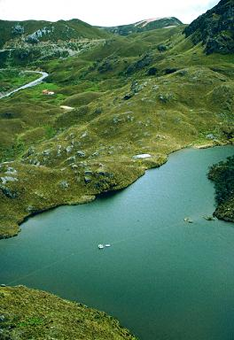NOAA/WDS Paleoclimatology - Unit Lake, Manitoba Holocene Multiproxy Sediment Data
This archived Paleoclimatology Study is available from the NOAA National Centers for Environmental Information (NCEI), under the World Data Service (WDS) for Paleoclimatology. The associated NCEI study type is Lake. The data include parameters of climate reconstructions|paleolimnology with a geographic location of Manitoba, Canada. The time period coverage is from 8737 to -64 in calendar years before present (BP). See metadata information for parameter and study location details. Please cite this study when using the data.
Dataset Citation
- Cite as: Camill, P.; Umbanhowar Jr., C.E.; Geiss, C.; Hobbs, W.O.; Edlund, M.B.; Cook Shinneman, A.; Dorale, J.A.; Lynch, J.A. (2012-06-30): NOAA/WDS Paleoclimatology - Unit Lake, Manitoba Holocene Multiproxy Sediment Data. [indicate subset used]. NOAA National Centers for Environmental Information. https://doi.org/10.25921/6bc3-sd84. Accessed [date].
- Please refer to Credit tab for full citation information.
Dataset Identifiers
- doi:10.25921/6bc3-sd84
- noaa-lake-13097
- NCEI DSI 1200_02
- NCEI DSI 1200_01
ISO 19115-2 Metadata
noaa-lake-13097
| Search Data |
|
| Download Data |
|
| Distribution Formats |
|
| Ordering Instructions | Contact NCEI for other distribution options and instructions. |
| Distributor |
NOAA National Centers for Environmental Information ncei.info@noaa.gov |
| Dataset Point of Contact |
NOAA National Centers for Environmental Information ncei.info@noaa.gov |
| Dataset Point of Contact | Data Center Contact NOAA World Data Service for Paleoclimatology 828-271-4800 paleo@noaa.gov |
| Coverage Description | Date Range: 8737 cal yr BP to -64 cal yr BP; |
| Time Period | -6787 to 2014 |
| Spatial Bounding Box Coordinates |
West: -97.493
East: -97.493
South: 59.404
North: 59.404
|
| Spatial Coverage Map |
| General Documentation |
|
| Associated Resources |
|
| Publication Dates |
|
| Data Presentation Form | Digital table - digital representation of facts or figures systematically displayed, especially in columns |
| Dataset Progress Status | Complete - production of the data has been completed |
| Data Update Frequency | Data update frequency not available |
| Supplemental Information | STUDY NOTES: Multiproxy sediment data from Unit Lake, Manitoba for the past 12,000 years. Paleoenvironmental proxies measured include fossil pollen and diatom assemblages, charcoal, magnetic properties (susceptibility and remanance), mineral grain size, bulk density, organic-matter content, elemental geochemistry, sediment cation (K+, Mg2+, Ca2+, Fe2+/Fe3+) and macronutrient (P, N, C) contents, biogenic-silica content, basal peat dates (wetland initiation), and stable isotopes (d13C, d15N). Unit Lake, Manitoba, Canada: 59.404°N, 97.493°W, 294m elevation, 11m water depth. ABSTRACT SUPPLIED BY ORIGINATOR: The low-Arctic region of western Hudson Bay in interior Canada is one of the most poorly described areas of North America in terms of Holocene climate history. Here, we present new data from a well-dated lake sediment core from northern Manitoba, Canada. We assemble one of the richest multi-proxy datasets to date for a low-Arctic lake and characterize terrestrial and lake processes and exchanges between them. These proxies include fossil pollen and diatom assemblages, charcoal, magnetic properties (susceptibility and remanance), mineral grain size, bulk density, organic-matter content, elemental geochemistry, sediment cation (K+, Mg2+, Ca2+, Fe2+/Fe3+) and macronutrient (P, N, C) contents, biogenic-silica content, basal peat dates (wetland initiation), and stable isotopes (d13C, d15N). The sediment proxies record both broad- and fine-scale (millennial and sub-millennial) climate change. We find indirect evidence for a cool and dry post-glacial period from 9,000 to 6,500 cal yr BP, a warm and moist mid-Holocene period from 6,500 to 2,500 cal yr BP, and a cool and moist late-Holocene period from 2,500 cal yr BP to present. High-resolution geochemical data suggests 300- to 500-year-long dry periods at ~6,500-6,100, 5,300-5,000, 3,300-2,800, and 400-0 cal yr BP. These results suggest that terrestrial and aquatic ecosystem dynamics in the western Hudson Bay region are sensitive to past climate change and are likely to respond to future changes in temperature and precipitation. |
| Purpose | Records of past climate and environment derived from lake sediment records. Parameter keywords describe what was measured in this dataset. Additional summary information can be found in the abstracts of papers listed in the dataset citations. |
| Dataset Citation |
|
| Cited Authors |
|
| Originators |
|
| Publishers |
|
| Theme keywords |
Global Change Master Directory (GCMD) Science Keywords
|
| Data Center keywords |
Global Change Master Directory (GCMD) Data Center Keywords
|
| Place keywords |
|
| Use Constraints |
|
| Access Constraints |
|
| Fees |
|
Last Modified: 2024-04-04
For questions about the information on this page, please email: ncei.info@noaa.gov
For questions about the information on this page, please email: ncei.info@noaa.gov

